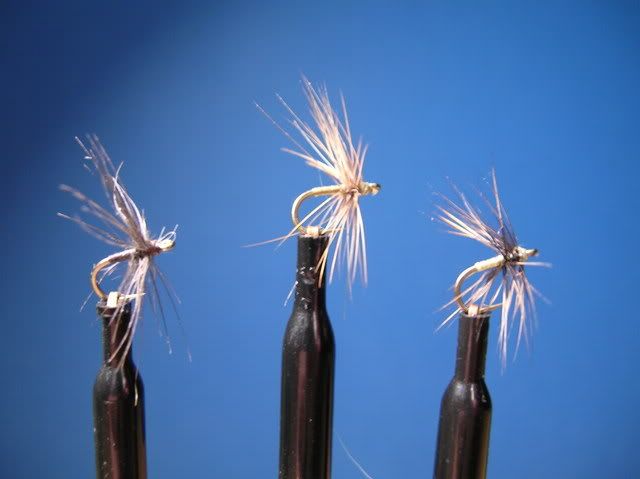
I'd have to have some Baillie's Spiders with me in size 14. These flies have been fooling fish since around 1835 or so. They are still around because they are so darned effective. Here's a picture of some Baillie's Spiders.

From left to right, Black, Red and Dun
Tying instructions for Baillie's Black Spider.
Hook: Daiichi 1640 size 14 or any straight eye, 2XShort dry fly hook.
Thread: Pearsall's Brown Gossamer Silk, well waxed till almost black, or any black thread.
Catch in the thread right behind the hook eye with three turns of thread. Snip off tag end of thread. Tie in Starling body or neck feather by the stem with the tip of the feather pointing over the eye of the hook. Wrap thread in touching turns down the shank till even with the hook barb. Wrap thread 1/2 to 2/3 way back to the hook eye in touching turns and let bobbin holder hang. Take the tip of the Starling feather in your hackle pliers and wrap the feather back, in open turns, to where the bobbin holder is hanging. Secure the feather with one or two wraps of thread then advance the thread toward the hook eye in open turns. Wiggle the thread as you wrap through the hackle to avoid trapping hackle barbs. At the eye of the hook make a small neat head, whip finish and trim thread and excess hackle.
For the Baillie's Red Spider:
Substitute Pearsall's Gossamer Primrose Yellow silk, well waxed till light olive in color or use a light olive thread. Substitute a reddish brown hen hackle for the Starling. Tying sequence is the same.
For the Baillie's Dun Spider use the same thread as for the Red Spider, substitute a dun hen hackle for the red. Tying sequence is the same.
Fishing Instructions:
If allowed, use a three fly wet fly cast using one of each color, then use what ever fly the fish are hitting. These are tied on light wire hooks, so they will be in or just under the surface film.
If using one, two or three flies, cast upstream and dead drift the flies downstream. Takes while the flies are upstream tend to be somewhat subtle. As the flies move past you and drift downstream, fish them on a standard wet fly swing, until the are directly downstream of you. Takes while the flies are downstream tend to be violent and aggressive
Last edited by Ron Eagle Elk; 12-14-2008 at 08:39 PM.
Happiness is wading boots that never have a chance to dry out.





 Reply With Quote
Reply With Quote
